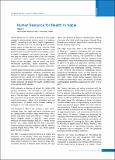Please use this identifier to cite or link to this item:
https://hdl.handle.net/20.500.14356/1842Full metadata record
| DC Field | Value | Language |
|---|---|---|
| dc.contributor.author | Magar, A | - |
| dc.date.accessioned | 2023-05-26T05:53:05Z | - |
| dc.date.available | 2023-05-26T05:53:05Z | - |
| dc.date.issued | 2013 | - |
| dc.identifier.citation | AM. (2013). Human Resource for Health in Nepal. Journal of Nepal Health Research Council. https://doi.org/10.33314/jnhrc.v0i0.373 | en_US |
| dc.identifier.issn | Print ISSN: 1727-5482; Online ISSN: 1999-6217 | - |
| dc.identifier.uri | http://103.69.126.140:8080/handle/20.500.14356/1842 | - |
| dc.description | Editorial | en_US |
| dc.description.abstract | Abstract Human Resources for Health is defined as “all people engaged in actions whose primary intent is to enhance healthâ€, according to the World Health Organization's (WHO).1 The HRH is one of the building block of health system which includes doctors, nurse, dentists, allied health professions, community health workers, social health workers and other health care providers, as well as health management and support personnel – those who may not deliver services directly but are essential to effective health system functioning, including health services managers, medical records and health information technicians, health economists, health supply chain managers, medical secretaries, and others. | en_US |
| dc.language.iso | en | en_US |
| dc.publisher | Nepal Health Research Council | en_US |
| dc.relation.ispartofseries | May-Aug, 2013;373 | - |
| dc.title | Human Resource for Health in Nepal | en_US |
| dc.type | Journal Article | en_US |
| local.journal.category | Editorial | - |
| Appears in Collections: | Vol. 11 No. 2 Issue 24 May - Aug, 2013 | |
Files in This Item:
| File | Description | Size | Format | |
|---|---|---|---|---|
| 373-Article Text-408-1-10-20131127.pdf | Fulltext Download | 136.9 kB | Adobe PDF |  View/Open |
Items in DSpace are protected by copyright, with all rights reserved, unless otherwise indicated.
